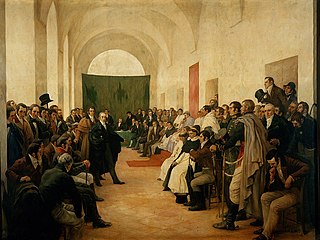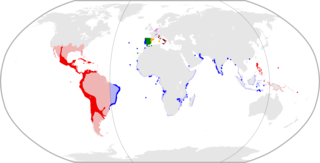
The Argentine War of Independence was a secessionist civil war fought from 1810 to 1818 by Argentine patriotic forces under Manuel Belgrano, Juan José Castelli and José de San Martín against royalist forces loyal to the Spanish crown. On July 9, 1816, an assembly met in San Miguel de Tucumán, declaring independence with provisions for a national constitution.

Captain Ramón Power y Giralt was, according to Puerto Rican historian Lidio Cruz Monclova, among the first native-born Puerto Ricans to refer to himself as a "Puerto Rican" and to fight for the equal representation of Puerto Rico before the Cortes of Cádiz, the parliamentary government of Spain at the time.

The Political Constitution of the Spanish Monarchy, also known as the Constitution of Cádiz and as La Pepa, was the first Constitution of Spain and one of the earliest codified constitutions in world history. The Constitution was ratified on 19 March 1812 by the Cortes of Cádiz, the first Spanish legislature that included delegates from the entire nation, including Spanish America and the Philippines. "It defined Spanish and Spanish American liberalism for the early 19th century."

The May Revolution was a week-long series of events that took place from May 18 to 25, 1810, in Buenos Aires, capital of the Viceroyalty of the Río de la Plata. This Spanish colony included roughly the territories of present-day Argentina, Bolivia, Paraguay, Uruguay, and parts of Brazil. The result was the removal of Viceroy Baltasar Hidalgo de Cisneros and the establishment of a local government, the Primera Junta, on May 25.

The Primera Junta or Junta Provisional Gubernativa de las Provincias del Río de la Plata, is the most common name given to the first government of what would eventually become Argentina. It was formed on 25 May 1810, as a result of the events of the May Revolution. The Junta initially only had representatives from Buenos Aires. When it was expanded, as expected, with the addition of representatives from the other cities of the Viceroyalty of the Río de la Plata, it became popularly known instead as the Junta Grande or Junta Provisional Gubernativa de Buenos Aires. The Junta operated at El Fuerte, which had been used since 1776 as a residence by the viceroys.

The First Republic of New Granada, known despectively as the Foolish Fatherland, is the period in the history of Colombia immediately following the declaration of independence from Spain in 1810 and until the Spanish reconquest in 1816. The period between 1810 and 1816 in the Viceroyalty of New Granada was marked by such intense conflicts over the nature of the new government or governments that it became known as la Patria Boba. Constant fighting between federalists and centralists gave rise to a prolonged period of instability that eventually favored Spanish reconquest. Similar developments can be seen at the same time in the United Provinces of the Río de la Plata. Each province, and even some cities, set up its own autonomous junta, which declared themselves sovereign from each other.

The Council of the Indies, officially the Royal and Supreme Council of the Indies, was the most important administrative organ of the Spanish Empire for the Americas and those territories it governed, such as the Spanish East Indies. The crown held absolute power over the Indies and the Council of the Indies was the administrative and advisory body for those overseas realms. It was established in 1524 by Charles V to administer "the Indies," Spain's name for its territories. Such an administrative entity, on the conciliar model of the Council of Castile, was created following the Spanish conquest of the Aztec empire in 1521, which demonstrated the importance of the Americas. Originally an itinerary council that followed Charles V, it was subsequently established as an autonomous body with legislative, executive and judicial functions by Philip II of Spain and placed in Madrid in 1561. The Council of the Indies was abolished in 1812 by the Cortes of Cádiz, briefly restored in 1814 by Ferdinand VII of Spain, and definitively abolished in 1834 by the regency, acting on behalf of the four-year-old Isabella II of Spain.

The Chilean War of Independence was a military and political event that allowed the emancipation of Chile from the Spanish Monarchy, ending the colonial period and initiating the formation of an independent republic.

Francisco Antonio García Carrasco Díaz was a Spanish soldier and Royal Governor of Chile. His political relations with Juan Martinez de Rozas and a smuggling scandal involving the frigate Scorpion destroyed what little authority he had, and required that he surrender his post to Mateo de Toro Zambrano President of the first govermennt board. He was the last governor to rule before the Chilean independence movement swept the country.

The Diocese of Ourense is one of five dioceses of the Roman Catholic Church in Galicia, northwestern Spain. The Bishop of Ourense has his cathedra in the Catedral de la Virgen Madre de los Milagros in Ourense and his jurisdiction covers all the 28 districts and 735 parishes of the Province of Ourense.

Pedro de Garibay was a Spanish military officer and, from September 16, 1808 to July 19, 1809, viceroy of New Spain.

Francisco Javier de Lizana y Beaumont was bishop of Mexico and, from July 19, 1809, to May 8, 1810, viceroy of New Spain.
In the Napoleonic era, junta was the name chosen by several local administrations formed in Spain during the Peninsular War as a patriotic alternative to the official administration toppled by the French invaders. The juntas were usually formed by adding prominent members of society, such as prelates, to the already-existing ayuntamientos. The juntas of the capitals of the traditional peninsular kingdoms of Spain styled themselves "Supreme Juntas", to differentiate themselves from, and claim authority over, provincial juntas. Juntas were also formed in Spanish America during this period in reaction to the developments in Spain.

Antonio José Amar y Borbón Arguedas was a Spanish military officer and colonial official. From September 16, 1803 to July 20, 1810 he was viceroy of New Granada. During his mandate he faced the beginning of the independence movement. He is also remembered for introducing costumes and masked balls in the society of Bogotá.

José Miguel Pey y García de Andrade was a Colombian statesman and soldier and a leader of the independence movement from Spain. He is considered the first vice president and first president of Colombia. He was a centralist.

Antonio Villavicencio y Verástegui was a statesman and soldier of New Granada, born in Quito, and educated in Spain. He served in the Battle of Trafalgar as an officer in the Spanish Navy with the rank of Second Lieutenant. He was sent as a representative of the Spanish Crown to New Granada, where his arrival was used as an excuse in Santafé de Bogotá to start a revolt; this was known as the Florero de Llorente, which culminated in the proclamation of independence from Spain. After this incident he resigned his office and joined the cause of independence. He was later captured and became the first martyr executed during the reign of terror of Pablo Morillo.

The royalists were the people of Hispanic America and European that fought to preserve the integrity of the Spanish monarchy during the Spanish American wars of independence.

The Colombian Declaration of Independence occurred on July 20, 1810 when the Junta de Santa Fe was formed in Santa Fe de Bogota, the capital of the Spanish colonial Viceroyalty of New Granada, to govern the territory autonomously from Spain. The event inspired similar independence movements across Latin America, and triggered an almost decade-long rebellion culminating in the founding of the Republic of Gran Colombia, which spanned present-day Colombia, mainland Ecuador, Panama, and Venezuela, along with parts of northern Peru and northwestern Brazil.
The Supreme Central and Governing Junta of Spain and the Indies formally was the Spanish organ (junta) that accumulated the executive and legislative powers during the Napoleonic occupation of Spain. It was established on 25 September 1808 following the Spanish victory at the Battle of Bailén and after the Council of Castile declared null and void the abdications of Charles IV and Ferdinand VII at Bayonne earlier in May. It was active until 30 January 1810. It was initially formed by the representatives of the provincial juntas and first met in Aranjuez chaired by the Count of Floridablanca, with 35 members in total.
Quevedo is a Spanish surname. Notable people with the surname include:

















